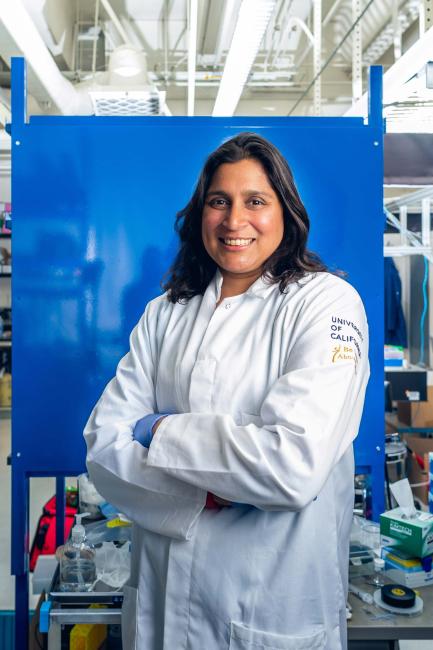Breaking Through Advancing Medicine by Way of Research

Diabetes
Sumita Pennathur
The work
 Driven by her daughter’s Type 1 diabetes diagnosis, Sumita Pennathur is steadfastly focused on developing solutions to help diabetes patients better manage their condition. Among them: a disposable patch for insulin delivery and a cannula that can remove preservatives known to be toxic from insulin before it enters the body. With a major grant — the Visionary Award — from the American Diabetes Association, she and her team have been successful on both fronts. Using the science of nonlinear electrokinetic flow, the Pennathur Lab was able to innovate a novel mechanism to pump insulin at very precise volumes and flow rates at a very small scale. Based on their results, in May 2023 they were awarded a grant from the Juvenile Diabetes Research Foundation to help move their proof of- concept device into the prototype phase. By mimicking chemistries used in nature to arrest passivation, the group also innovated a method to remove phenol and metacresol within the cannula itself – as those excipients are important for stabilizing insulin in the reservoir, but can be toxic to the patient.
Driven by her daughter’s Type 1 diabetes diagnosis, Sumita Pennathur is steadfastly focused on developing solutions to help diabetes patients better manage their condition. Among them: a disposable patch for insulin delivery and a cannula that can remove preservatives known to be toxic from insulin before it enters the body. With a major grant — the Visionary Award — from the American Diabetes Association, she and her team have been successful on both fronts. Using the science of nonlinear electrokinetic flow, the Pennathur Lab was able to innovate a novel mechanism to pump insulin at very precise volumes and flow rates at a very small scale. Based on their results, in May 2023 they were awarded a grant from the Juvenile Diabetes Research Foundation to help move their proof of- concept device into the prototype phase. By mimicking chemistries used in nature to arrest passivation, the group also innovated a method to remove phenol and metacresol within the cannula itself – as those excipients are important for stabilizing insulin in the reservoir, but can be toxic to the patient.
The why
 “I was born into an immigrant family where my parents had an unbelievable work ethic, one I very much respected. In response, I have always worked incredibly hard to achieve. After becoming a professor and having kids, I shifted my efforts into trying to help the quality of life of people. Specifically, when my third child died in the hospital at 28 weeks, I really felt the pain of losing a life, and started focusing on tangible and translational med tech. A year later when my second child was diagnosed with diabetes, I knew I had to put 1,000% effort into making sure she stays alive and well. It gives me amazing motivation every day.” — Sumita Pennathur
“I was born into an immigrant family where my parents had an unbelievable work ethic, one I very much respected. In response, I have always worked incredibly hard to achieve. After becoming a professor and having kids, I shifted my efforts into trying to help the quality of life of people. Specifically, when my third child died in the hospital at 28 weeks, I really felt the pain of losing a life, and started focusing on tangible and translational med tech. A year later when my second child was diagnosed with diabetes, I knew I had to put 1,000% effort into making sure she stays alive and well. It gives me amazing motivation every day.” — Sumita Pennathur
The impact
 More than 37 million Americans — about one in 10 — have diabetes, according to the Centers for Disease Control and Prevention. Worldwide that figure has surged to nearly half a billion. For Type 1 diabetics whose bodies don’t make insulin, or for Type 2 patients whose bodies don’t use insulin well, significant advancements in insulin delivery are crucial to quality of life.
More than 37 million Americans — about one in 10 — have diabetes, according to the Centers for Disease Control and Prevention. Worldwide that figure has surged to nearly half a billion. For Type 1 diabetics whose bodies don’t make insulin, or for Type 2 patients whose bodies don’t use insulin well, significant advancements in insulin delivery are crucial to quality of life.